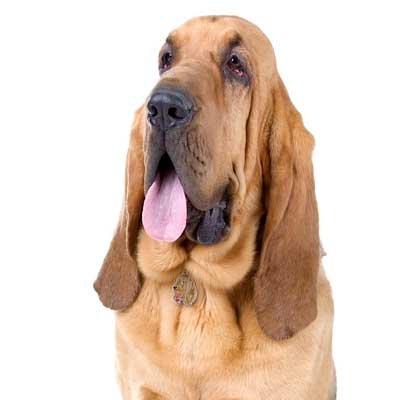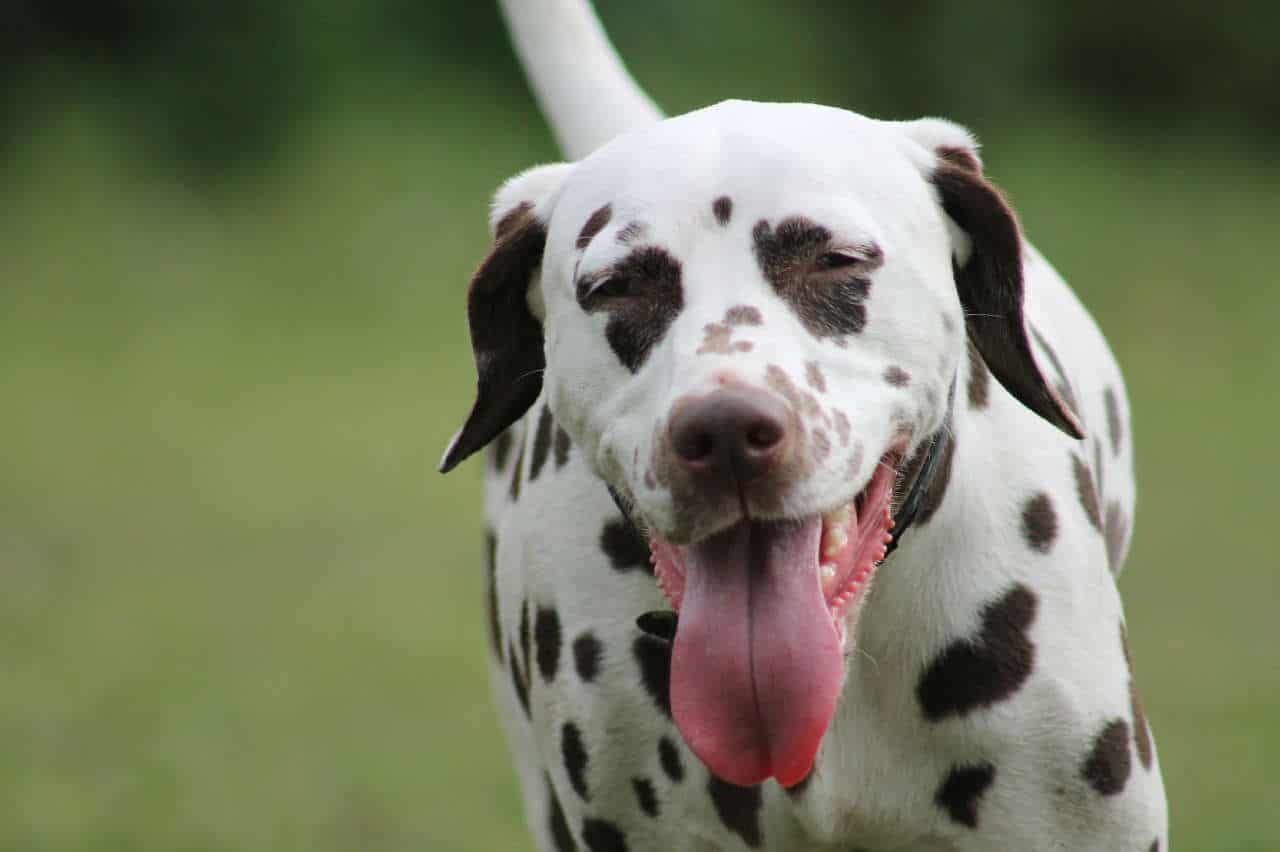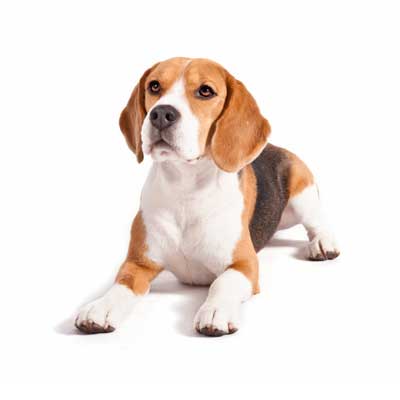Bloodhound Chien De Saint-Hubert
Appreciated for its nose, it is a sociable and gentle dog with everyone
Large-sized hound with very ancient origins.For centuries he has been known and appreciated for his exceptional flair and his skills as a hunter. It was raised in the Ardennes by the monks of the Abbey of Saint Hubert.It would descend from the black or black and tan hounds that were employed in the seventh century by the monk Hubert who, later, was appointed bishop and who, canonized, became the patron saint of hunters.
-
Head
Imposing, majestic and full of nobility, it is the most characteristic point of the breed. It is tall, but narrow compared to its length and long compared to the length of the body.
The bone structure is clearly visible. The side faces are flattened and the profile is square. The bridge of the nose is roughly parallel to the prolonged upper line of the forehead.
The skin, abundant and fine, forms deep wrinkles and folds on the forehead and cheeks, which fall back when the head is carried low and which extend into the folds of the very developed dewlap.
The skin is less abundant in females. -
Head - region of the skull
Skull: it is tall, long, rather narrow and the lateral faces are flattened. The eyebrow arches are not very prominent, although they may seem so.
The occipital protuberance is very developed and distinctly raised.
Stop: not very marked -
Head - region of the muzzle
Nose: black or brown; always black in black and tan dogs. The nose is broad, well developed, and the nostrils well opened.
Muzzle: Long as the skull, high, broad near the nostrils and of equal width throughout its length. The bridge of the nose is either well straight or a little curved (slightly ram)
Lips: very long and sagging; the upper lips hang over the lower ones and form a right angle with the nose bridge in front, which gives a square profile to the muzzle. Behind, towards the commissures, they become fleshy pendulous lips (less pronounced in females), which blend imperceptibly with the abundant dewlap. The edge of the upper lips descends 5 cm lower than the lower jaw. The edge of the lips is well pigmented, black or brown, according to the color of the nose
Jaws / Teeth: Complete dentition, correct scissor bite; strong white teeth, regularly set in well developed jaws; pincer tolerated
Cheeks: Hollow and lean, especially under the eyes
Eyes: dark brown or hazel, of a lighter color (amber) in dogs without saddle or black saddlecloth. Medium sized eyes; oval, not tearful, nor protruding, nor sunken in the eye sockets, which leave the iris completely visible. Eyelids without irregularities in their outline, normally adapted to the eyeball; the lower eyelids a little loose, so that some conjunctiva is visible, are therefore tolerated. In no case can the eyelashes touch and disturb the eyes. The expression is sweet, gentle and dignified, the look a little melancholy.
Ears: thin and soft, covered with short hair, fine and velvety to the touch; very long pavilions, which exceed at least the tip of the nose when they are placed on the bridge of the nose; Ears set very low, at eye level or lower, on the side of the head, falling in graceful folds, rolled inwards and backwards (a tirebouchon) -
Neck
long, so that the dog can follow the trail with its nose on the ground; very muscular; the skin of the throat is loose and extremely developed, and has a double dewlap (but less in females).
-
Body
the upper and lower lines are almost parallel
Withers: Slightly marked
Back: straight, broad, long and solid
Loin: broad, strong, short, very slightly arched
Croup: Much muscled, almost horizontal, never hollow, very broad and rather long
Thorax: oval in shape, wide, high, clearly forming a hull between the forelegs. Ribcage long enough. Chest and shoulder point clearly visible. Ribs well sprung, neither flat nor barrel.
Lower line and belly: almost horizontal lower line. Lower chest deep. Hips very full, broad and deep, stomach only slightly retracted -
Tail
long, strong, thick, set high, on the extension of the topline; it gradually tapers towards the extremity; carried like a saber; in action, the tail is elegantly curved above the dorsal line, never curled or deviated laterally; the lower part of the tail is covered with a rougher hair, about 5 cm, which becomes progressively shorter towards the end. -
Front limbs
Overall: very muscular; the forelegs are powerful, straight and perfectly parallel
Shoulder: Long, well laid back and muscular, but not heavy
Upper arm: Long, oblique, forming a good angle with the shoulder
Elbow: Close fitting, neither low cut nor too closed
Forearm: Straight, strong and round bone
Wrist: firm
Pastern: robust, upright seen from the front, slightly inclined towards the front when seen in profile
Front foot: compact, very solid; deflected neither in nor out; fingers well
arched, well articulated and closed (cat's foot); thick and solid bearings; short and strong nails -
Hind limbs
Overall: solid, powerfully muscled, in harmony with the forelimbs; seen from behind perfectly parallel, neither narrow nor open.
Upper thigh: Of good length and very muscular
Knee: Well angulated: turned neither in nor out
Lower thigh: Sufficiently long and very muscular
Hock: solid, deep and very angled
Hock: strong and short.
Foot: like the front -
Gait
the judgment of movement, very typical in Bloodhounds, is extremely important. At the trot, its normal gait, the movement is regular, with measured steps, elastic and free; it covers more ground than all other hounds, and what is very characteristic, rolling, but not walking sideways.
The hindquarters stretch well backwards, there is a good push from the hindquarters, the amplitude of the movements of the front and rear is the same, and the top line remains horizontal. The limbs move parallel, but at a higher speed the feet come closer.
The tail is carried high, saber-like, without the curve becoming too pronounced. The Bloodhound must be able to maintain the trot for a long time, without showing signs of fatigue. -
Skin
soft all over the body, loose and supple. The fine skin, very loose and abundant on the head, is very characteristic.
On the forehead and the lateral faces of the muzzle, the skin forms folds which hang down and which are more accentuated even when the head is carried low.
However, too pronounced wrinkles and folds on the forehead and the eyebrow arches should never harm the eyes.
Folds of skin on the body, due to too much skin, are not desirable. -
Cloak - hair
on the body, the hair, well laid down, is short, dense, quite hard and resistant to bad weather.
On the head and ears the hair is very short and soft to the touch.
The underside of the tail is covered with longer and rougher hair. -
Cloak - color
three colors of the coat can be distinguished: the two-colored black-and-tan (“black and tan”) and liver-and-tan (“liver and tan”), and the one-colored fawn (“red”).
In black and tan the black part varies, depending on whether it is a saddle cloth or a saddle.
In the black-backed dog, black is predominant; the focus (fawn) is found only on the muzzle, cheeks, above the eyes, on the chest, limbs and in the area around the anus.
A dog with a saddle has more extensive fire zones, since the black is more or less limited to the dorsal part. The same arrangements of colored zones occur in the two-tone liver and fire.
Colors are not always distinct, nor are they clearly delimited. In the darker parts, lighter or badger-colored scattered hairs may appear. Such mix of different colors is allowed.
In the fawn monocolor, fawn can vary from light fawn to dark fawn.
A faded fiery color in two-tone or faded tawny in single-color is undesirable. A little white on the chest, toes and at the tip of the tail is tolerated without being desired. -
Size and weight
Height at the withers: The ideal height is cm. 68 for males 62 for females with a tolerance of 4 cm. less or more
Weight: Males about 46-54 Kg - Females 40-48 Kg
Size and weight must be in harmony -
Defects
any deviation from the above must be considered a defect and the severity with which it should be penalized must be proportionate to its gravity
- General appearance: coarse; little substance; light bone; high or low on the limbs; construction more in the square than in the rectangle; lack of nobility.
- Head: skull broad and voluminous or excessively narrow. Receding forehead. Forehead skin too carried forward. Little pronounced occipital protuberance. Stop too pronounced. Concave nasal bridge. Muzzle short or not very high. Upper lips not hanging enough
- Nose and lips: loss of pigment
- Teeth: lack of teeth
- Eyes: too small, too sunken in the sockets. Lower lids too saggy. Too much conjunctiva visible
- Ears: too short, too thick, attached above eye level, too close to the head or too flat
- Neck: short, slender, little dewlap
- Body: short or too long. Chest slightly descended. Chest slightly protruding in profile. Flat or barrel ribs. Weak or arched back. Raised or depressed croup. Belly too tucked up.
Tail: set low. Squirrel tail, ring, rolled up; gnarled or broken; hooked or deviated tail.
- Limbs: too little or too angled; short arm. Bad aplomb in profile (ex: pasterns too oblique or weak wrists), in front (ex: left or dog feet, forearm, unglued elbows, etc.) or from behind (ex: hindquarters too close, too far apart or dogs, closed hocks or
open etc.). Feet open, hare or flat.
- Movement: closed, open. Dog that crosses, that goes sideways. Short steps or sliced gait. Little impulse, back that does not transmit thrust
- Hair color: light or faded colors
- Character: insecure or nervous -
Eliminating defects
- Character: aggressive or overly fearful subjects
- General aspect: lack of typicality
- Dentition: overshot or undershot bite - Cross bite. Crooked mouth
- Nose and lips: very depigmented or pink in color. Other than black in black and tan. Other than brown or black in dogs without saddle or black saddle cloth
- Eyes: light yellow (raptor eyes)
- Character: aggressive or overly fearful subjects
- General aspect: lack of typicality
- Dentition: overshot or undershot bite - Cross bite. Crooked mouth
- Nose and lips: very depigmented or pink in color. Other than black in black and tan. Other than brown or black in dogs without saddle or black saddle cloth
- Eyes: light yellow (raptor eyes)
- Coat color: all colors that do not correspond to the descriptions: white markings that are too extensive, such as white that goes up to the wrists or hocks, or white that is too extensive on the chest. White markings elsewhere than on the chest, toes and tip of the tail, such as a white muzzle, a white stripe
etc.
- Size: out of tolerance
A dog that shows any sign of physical anomaly must be eliminated from the judgment.
etc.
- Size: out of tolerance
A dog that shows any sign of physical anomaly must be eliminated from the judgment.






